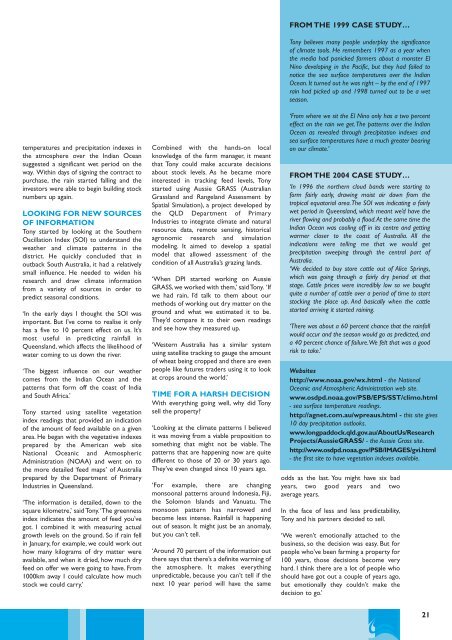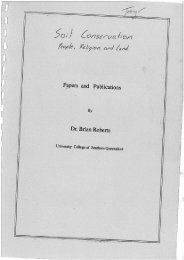Masters of the Climate: Innovative farmers ... - South West NRM
Masters of the Climate: Innovative farmers ... - South West NRM
Masters of the Climate: Innovative farmers ... - South West NRM
You also want an ePaper? Increase the reach of your titles
YUMPU automatically turns print PDFs into web optimized ePapers that Google loves.
temperatures and precipitation indexes in<br />
<strong>the</strong> atmosphere over <strong>the</strong> Indian Ocean<br />
suggested a significant wet period on <strong>the</strong><br />
way. Within days <strong>of</strong> signing <strong>the</strong> contract to<br />
purchase, <strong>the</strong> rain started falling and <strong>the</strong><br />
investors were able to begin building stock<br />
numbers up again.<br />
LOOKING FOR NEW SOURCES<br />
OF INFORMATION<br />
Tony started by looking at <strong>the</strong> Sou<strong>the</strong>rn<br />
Oscillation Index (SOI) to understand <strong>the</strong><br />
wea<strong>the</strong>r and climate patterns in <strong>the</strong><br />
district. He quickly concluded that in<br />
outback <strong>South</strong> Australia, it had a relatively<br />
small influence. He needed to widen his<br />
research and draw climate information<br />
from a variety <strong>of</strong> sources in order to<br />
predict seasonal conditions.<br />
‘In <strong>the</strong> early days I thought <strong>the</strong> SOI was<br />
important. But I’ve come to realise it only<br />
has a five to 10 percent effect on us. It’s<br />
most useful in predicting rainfall in<br />
Queensland, which affects <strong>the</strong> likelihood <strong>of</strong><br />
water coming to us down <strong>the</strong> river.<br />
‘The biggest influence on our wea<strong>the</strong>r<br />
comes from <strong>the</strong> Indian Ocean and <strong>the</strong><br />
patterns that form <strong>of</strong>f <strong>the</strong> coast <strong>of</strong> India<br />
and <strong>South</strong> Africa.’<br />
Tony started using satellite vegetation<br />
index readings that provided an indication<br />
<strong>of</strong> <strong>the</strong> amount <strong>of</strong> feed available on a given<br />
area. He began with <strong>the</strong> vegetative indexes<br />
prepared by <strong>the</strong> American web site<br />
National Oceanic and Atmospheric<br />
Administration (NOAA) and went on to<br />
<strong>the</strong> more detailed ‘feed maps’ <strong>of</strong> Australia<br />
prepared by <strong>the</strong> Department <strong>of</strong> Primary<br />
Industries in Queensland.<br />
‘The information is detailed, down to <strong>the</strong><br />
square kilometre,’ said Tony.‘The greenness<br />
index indicates <strong>the</strong> amount <strong>of</strong> feed you’ve<br />
got. I combined it with measuring actual<br />
growth levels on <strong>the</strong> ground. So if rain fell<br />
in January, for example, we could work out<br />
how many kilograms <strong>of</strong> dry matter were<br />
available, and when it dried, how much dry<br />
feed on <strong>of</strong>fer we were going to have. From<br />
1000km away I could calculate how much<br />
stock we could carry.’<br />
Combined with <strong>the</strong> hands-on local<br />
knowledge <strong>of</strong> <strong>the</strong> farm manager, it meant<br />
that Tony could make accurate decisions<br />
about stock levels. As he became more<br />
interested in tracking feed levels, Tony<br />
started using Aussie GRASS (Australian<br />
Grassland and Rangeland Assessment by<br />
Spatial Simulation), a project developed by<br />
<strong>the</strong> QLD Department <strong>of</strong> Primary<br />
Industries to integrate climate and natural<br />
resource data, remote sensing, historical<br />
agronomic research and simulation<br />
modeling. It aimed to develop a spatial<br />
model that allowed assessment <strong>of</strong> <strong>the</strong><br />
condition <strong>of</strong> all Australia’s grazing lands.<br />
‘When DPI started working on Aussie<br />
GRASS, we worked with <strong>the</strong>m,’ said Tony. ‘If<br />
we had rain, I’d talk to <strong>the</strong>m about our<br />
methods <strong>of</strong> working out dry matter on <strong>the</strong><br />
ground and what we estimated it to be.<br />
They’d compare it to <strong>the</strong>ir own readings<br />
and see how <strong>the</strong>y measured up.<br />
‘<strong>West</strong>ern Australia has a similar system<br />
using satellite tracking to gauge <strong>the</strong> amount<br />
<strong>of</strong> wheat being cropped and <strong>the</strong>re are even<br />
people like futures traders using it to look<br />
at crops around <strong>the</strong> world.’<br />
TIME FOR A HARSH DECISION<br />
With everything going well, why did Tony<br />
sell <strong>the</strong> property?<br />
‘Looking at <strong>the</strong> climate patterns I believed<br />
it was moving from a viable proposition to<br />
something that might not be viable. The<br />
patterns that are happening now are quite<br />
different to those <strong>of</strong> 20 or 30 years ago.<br />
They’ve even changed since 10 years ago.<br />
‘For example, <strong>the</strong>re are changing<br />
monsoonal patterns around Indonesia, Fiji,<br />
<strong>the</strong> Solomon Islands and Vanuatu. The<br />
monsoon pattern has narrowed and<br />
become less intense. Rainfall is happening<br />
out <strong>of</strong> season. It might just be an anomaly,<br />
but you can’t tell.<br />
‘Around 70 percent <strong>of</strong> <strong>the</strong> information out<br />
<strong>the</strong>re says that <strong>the</strong>re’s a definite warming <strong>of</strong><br />
<strong>the</strong> atmosphere. It makes everything<br />
unpredictable, because you can’t tell if <strong>the</strong><br />
next 10 year period will have <strong>the</strong> same<br />
FROM THE 1999 CASE STUDY…<br />
Tony believes many people underplay <strong>the</strong> significance<br />
<strong>of</strong> climate tools. He remembers 1997 as a year when<br />
<strong>the</strong> media had panicked <strong>farmers</strong> about a monster El<br />
Nino developing in <strong>the</strong> Pacific, but <strong>the</strong>y had failed to<br />
notice <strong>the</strong> sea surface temperatures over <strong>the</strong> Indian<br />
Ocean. It turned out he was right – by <strong>the</strong> end <strong>of</strong> 1997<br />
rain had picked up and 1998 turned out to be a wet<br />
season.<br />
‘From where we sit <strong>the</strong> El Nino only has a two percent<br />
effect on <strong>the</strong> rain we get.The patterns over <strong>the</strong> Indian<br />
Ocean as revealed through precipitation indexes and<br />
sea surface temperatures have a much greater bearing<br />
on our climate.’<br />
FROM THE 2004 CASE STUDY…<br />
‘In 1996 <strong>the</strong> nor<strong>the</strong>rn cloud bands were starting to<br />
form fairly early, drawing moist air down from <strong>the</strong><br />
tropical equatorial area.The SOI was indicating a fairly<br />
wet period in Queensland, which meant we’d have <strong>the</strong><br />
river flowing and probably a flood.At <strong>the</strong> same time <strong>the</strong><br />
Indian Ocean was cooling <strong>of</strong>f in its centre and getting<br />
warmer closer to <strong>the</strong> coast <strong>of</strong> Australia. All <strong>the</strong><br />
indications were telling me that we would get<br />
precipitation sweeping through <strong>the</strong> central part <strong>of</strong><br />
Australia.<br />
‘We decided to buy store cattle out <strong>of</strong> Alice Springs,<br />
which was going through a fairly dry period at that<br />
stage. Cattle prices were incredibly low so we bought<br />
quite a number <strong>of</strong> cattle over a period <strong>of</strong> time to start<br />
stocking <strong>the</strong> place up. And basically when <strong>the</strong> cattle<br />
started arriving it started raining.<br />
‘There was about a 60 percent chance that <strong>the</strong> rainfall<br />
would occur and <strong>the</strong> season would go as predicted, and<br />
a 40 percent chance <strong>of</strong> failure.We felt that was a good<br />
risk to take.’<br />
Websites<br />
http://www.noaa.gov/wx.html - <strong>the</strong> National<br />
Oceanic and Atmospheric Administration web site.<br />
www.osdpd.noaa.gov/PSB/EPS/SST/climo.html<br />
- sea surface temperature readings.<br />
http://agnet.com.au/wpreaus.html - this site gives<br />
10 day precipitation outlooks.<br />
www.longpaddock.qld.gov.au/AboutUs/Research<br />
Projects/AussieGRASS/ - <strong>the</strong> Aussie Grass site.<br />
http://www.osdpd.noaa.gov/PSB/IMAGES/gvi.html<br />
- <strong>the</strong> first site to have vegetation indexes available.<br />
odds as <strong>the</strong> last. You might have six bad<br />
years, two good years and two<br />
average years.<br />
In <strong>the</strong> face <strong>of</strong> less and less predictability,<br />
Tony and his partners decided to sell.<br />
‘We weren’t emotionally attached to <strong>the</strong><br />
business, so <strong>the</strong> decision was easy. But for<br />
people who’ve been farming a property for<br />
100 years, those decisions become very<br />
hard. I think <strong>the</strong>re are a lot <strong>of</strong> people who<br />
should have got out a couple <strong>of</strong> years ago,<br />
but emotionally <strong>the</strong>y couldn’t make <strong>the</strong><br />
decision to go.’<br />
21
















